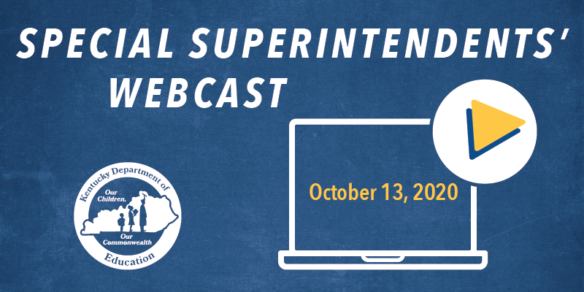
By Jim Gaines
jim.gaines@education.ky.gov
Three superintendents from around Kentucky and the leaders of their local health departments compared COVID-19 experiences during the Oct. 13 Special Superintendents’ Webcast. All agreed that close cooperation between schools, health authorities and local officials are essential to controlling outbreaks.
Kentucky Commissioner of Education and Chief Learner Jason E. Glass said the atmosphere of COVID-19 decision-making was chaotic at first, as there was much about the disease that was not understood. The situation has moved into a more complex phase as different strategies are tried and people share information, he said.
For now, people should not look for quick and simple solutions, Glass said. Leaders need to try different things, but be prepared for them to fail and have backup plans.
Berea Independent Schools
Berea Independent Schools has about 1,200 students in a county of nearly 95,000, Superintendent Dianne Hatchett said. The district’s three schools share one building.
A hundred people signed up to participate in three committees the district assembled to work out aspects of reopening, Hatchett said. The groups unanimously agreed to restart classes online only. Now small groups in need of targeted intervention are allowed into the school building, and the district is assessing whether to move to a hybrid model – a mix of virtual and in-person classes.
“Nothing moves forward unless we’ve actually consulted the health department,” she said. Hatchett calls the Madison County Health Department frequently.
Nancy Crewe, the department’s public health director, said she and Hatchett collaborate constantly to ensure schools meet health standards.
In a county that has seen 2,085 cases of COVID-19, Berea schools have had four people recover from the virus and one recently reported case, Crewe said.
Owsley County Schools
Owsley County has 700 students in K-12 and 90 in early and Head Start programs, Owsley County Schools Superintendent Tim Bobrowski said.
With a total of only 4,780 people, the county is so small that only nine new COVID-19 cases can put it in the “red zone” for high transmission, said Scott Lockard, public health director of Kentucky River District Health Department. His department serves seven counties, including Owsley, with a total of 94,000 people and nine school districts.
Bobrowski said Owsley County was better prepared to transition to virtual classes than some other districts due to its strong internet infrastructure and participation in the Non-Traditional Instruction Program (NTI) since 2011.
Classes resumed remotely on Aug. 24, but school officials started getting the community involved in July in planning for reopening, Bobrowski said.
The health district has worked closely with Bobrowski and a coalition of local organizations on plans for reopening schools, Lockard said. The good communication and personal contacts between leaders that already existed have been invaluable in dealing with COVID-19, he said.
“Whenever you’re in the middle of a crisis, you don’t have time to build these relationships, oftentimes; but that is when you need these relationships the most,” Lockard said.
Bobrowski said the district posts the latest information on social media, with Facebook serving as the primary channel. But he said he has learned that new developments must be posted quickly from official accounts to avoid being overtaken by fast-spreading rumors.
Hopkins County Schools
Hopkins County Schools has 6,400 students on 14 campuses in a county of 45,000, Superintendent Deanna Ashby said. After three weeks of NTI, schools held “soft openings” of a hybrid model before switching back to NTI this week. The district hopes to resume hybrid classes Oct. 26, following fall break, Ashby said.
Hopkins County saw a large number of COVID-19 cases early on and they spiked again two weeks ago, said Denise Beach, public health director at the Hopkins County Health Department. Hundreds of people are in quarantine, but the general public isn’t staying home and mask-wearing has declined, she said.
The county has Kentucky’s fifth-highest number of deaths, and last week the school system lost a 60-year-old bus driver to COVID-19, Beach said.
She said when it comes to the school system, she is pleased with the caution being taken and praised the district’s teamwork with the health department.
Ashby said one thing that has helped tremendously is having a full-time registered nurse on every campus.
The health department handles contact tracing of people who have been exposed to the virus, aided by school record-keeping. Soon a rapid screening test for COVID-19 will be available at each school and the in-school labs can even test the parents of children who have been exposed, Beach said. Hopkins County is probably the first district in the state to offer that, she said.
Ashby said schools participated in the creation of a county health task force with representatives from various agencies, and it has been so effective they plan to keep it going even after the COVID-19 crisis passes.
Participation Report
The Kentucky Department of Education will report a compilation of student participation to the state Legislative Research Commission at the end of this month, the first of three such reports this school year, said Robin Kinney, associate commissioner in KDE’s Office of Finance and Operations.
Under an emergency regulation, next year’s school funding has been decoupled from attendance numbers, she said. In spring 2020, schools had a choice of using either their 2018-2019 or 2019-2020 attendance records to calculate funding for the 2020-2021 school year.
This year they will do the same, using the same year’s data they did in spring 2020.
“Daily attendance will not be reported for this school year,” Kinney said. Instead, each day, schools must record remote student participation through Infinite Campus (IC). Attendance still will be taken if students are going to in-person classes.
District data on participation will be visible in IC on Oct. 15, said Jessi Carlton, assistant director in KDE’s Division of District Support. Districts will have until Oct. 30 to verify and correct their data covering the period from the start of school to Sept. 30, and KDE will pull the summary Nov. 2, she said.
Any questions can be emailed to Carlton at jessica.carlton@education.ky.gov.
COVID-19 Case Reporting
Per an emergency regulation, all Kentucky schools are required to use the COVID-19 self-reporting dashboard, said Dr. Connie White, deputy commissioner of the Kentucky Department for Public Health (DPH). This is not optional, she said.
Even if a district has no new cases or anyone in quarantine, zeros must be entered daily, White said.
Since that is the closest thing available to real-time reporting, daily updates to the dashboard will help dispel rumors of outbreaks by providing official information, she said.
Any district with problems using the dashboard should email White at DPH.
MORE INFO …



Leave A Comment